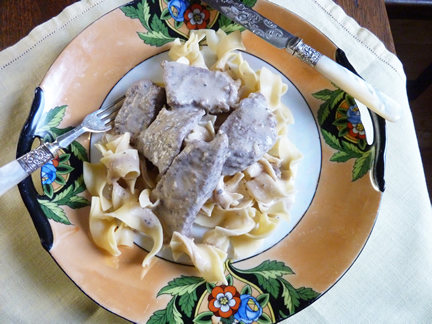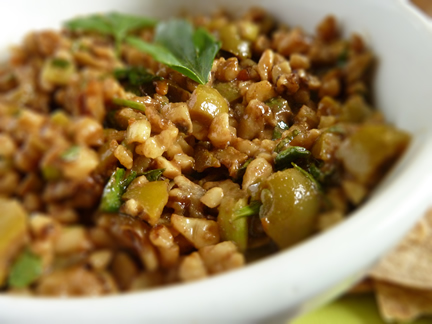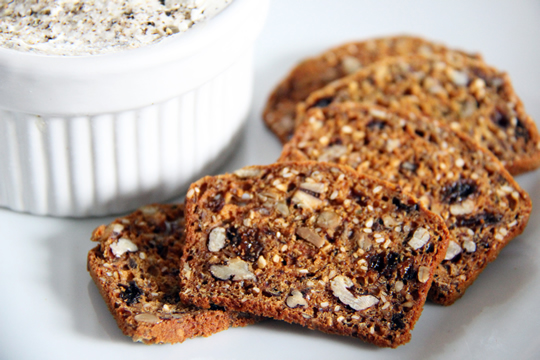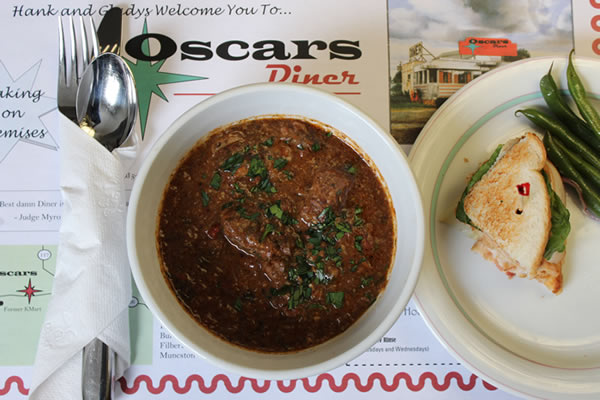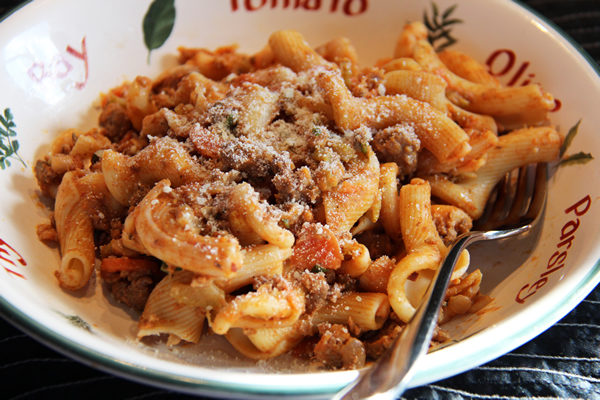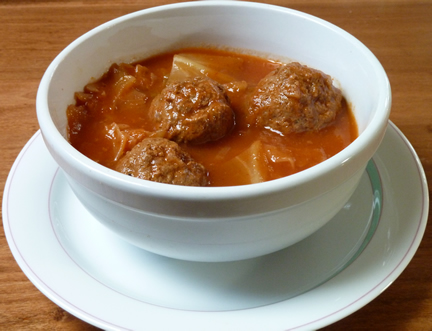Why do restaurants name so many dishes by their ingredients rather than after the chef, the locale, or even a favorite patron? In today’s can-you-top-this cuisine, maybe nobody wants to own up to such culinary contortions as “Crunchy Rabbit with Citrus-Chili Paste and Soybean Purée.” (A real entrée at the Jean-Georges Restaurant in New York City. Curiously, it sounds less mouth-watering than Monty Python’s “Crunchy Frog.” Feel free to stop here and view this sketch now.)
Brody’s Second Law of Marketing states that if you can’t name it, you can’t sell it. So why not brand a dish with a memorable name? And the granddaddy of them all is Beef Stroganoff.
This recipepany comes from one of my oldest friends, Wendy, who actually studied cooking in college. She reminds me that when she first served it to me, I told her that if I were a man, I would propose.
Nevertheless, I never thought to make it until now. What got me interested was a terrific Powerpoint presentation of the recipe—complete with an “Ochi Chernye” soundtrack—that Wendy recently made for a computer class. And when she said the recipe came from a real Russian Princess, I had to know the story.
Wendy said she got the recipe from a library book when she was in junior high. Only she didn’t remember the name of the Princess or the book. So I quickly put on my food anthropologist’s apron and got to work.
The Princess
Once upon a time there was a real Russian Princess named Alexandra Kropotkin. She was a direct descendent of the first tzar, but didn’t grow up in a palace, or even in Russia. And she probably wasn’t related to Count Pavel Stroganov, the 19th century diplomat and military leader credited with popularizing the dish.
Princess Alexandra was born in London, probably in the 1890s during her parents’ exile. Her father was the famous aristocrat-turned-anarchist, Prince Peter Alexeyevich Kropotkin. His subversive writings and activities in Russia had led to his arrest and imprisonment. He escaped to Europe where met his wife, a Russian student also in exile.
Princess Alexandra grew up in an atmosphere of philosophy, radical politics, and science. She became fluent in French, Russian, and English. Although she was steeped in Russian culture, she didn’t move to Russia until 1915. She was imprisoned during the Revolution and escaped to the US. I believe she married here, and worked to help liberate the Russian people from repression.
She described herself as a “linguist, traveler, lecturer, and authority on fashion.” She wrote breezy columns for women’s magazines in the 1930s, and translated War and Peace and other hefty classics in 1940s. Her engaging narrative and smart recipes in her book How to Cook and Eat in Russian (1947) gave America a glimpse of Russian life in general and the definitive Beef Stroganoff recipe in particular. She reissued it in 1964 as The Best of Russian Cooking.
And as far as I can figure, she lived happily ever after.
The Recipe
Craig Claiborne wrote in the Foreword to the 1964 edition that he discovered the book in a secondhand store (my kind of guy) and it became his go-to reference for Russian cooking. He praised it for its faithful depiction of the Russian heritage. He singled out Beef Stroganoff, saying it “is as popular at a church social in the mid-West as it is in a Manhattan penthouse.”
And its popularity has endured. Matt Damon recently called Beef Stroganoff his signature dish, which he made mostly because his mom forced him to cook once a week.
But what is the real Beef Stroganoff? The Princess makes it clear: no mushrooms. And although she browns onions in with the steak, she says not to put them back into the dish for serving. Leaving them out keeps the sauce light and focuses on the flavor and texture of the meat. (Of course, I eat them on the side.)
The Princess says that the secret to the dish is the mustard. I prefer a slightly sweeter mustard, so I combine Nance’s sharp and creamy mustard with Dijon.
The original recipe specified “thick” sour cream. Today that’s an unnecessary adjective. But back then, sour cream as we know it (similar to smetana in Russia) was a relatively new product in America.
Note also that the steak is only gently heated after browning. This keeps it tender.
Wendy’s delicious adaptation includes more flour and butter to make thicker sauce, and more mustard. Wendy, good cook that she is, adapts it to her tastes, and she encourages me to do the same.
Below is the Princess’s recipe from the 1964 edition, with a couple of my notes. Along with her recipe, she wrote, “Even this classic recipe has undergone local changes over the past 20 years. Through the south of Russia 1 tablespoon of tomato puree has crept into the sauce. Or a few cooked mushroom slices may be introduced. In America, the tomato puree and the mushrooms are both added. The result is tasty, I admit. But it isn’t Beef Stroganoff.”
And that, my friends, is the story of the Princess and the Recipe.
Beef Stroganoff
- 1½ pounds fillet of beef or lean part of the tenderloin (Note: I use top sirloin.)
- 1½ teaspoons salt
- 2 teaspoons pepper
- 3 tablespoons butter
- 1 tablespoon flour
- 1 cup consommé (Note: I use bouillon.)
- 1 teaspoon prepared hot mustard
- 1 onion sliced
- 3 tablespoons sour cream
- Remove all fat and gristle from the meat. Cut it in narrow strips about 2 inches long and ½ inch thick. Dust the strips of beef with the salt and pepper, then set them aside for 2 hours. Do not put them in a cold place.
- Melt 1½ tablespoons of the butter and blend in the flour. Add the consommé and boil up. Stir in the mustard.
- Now in another pan brown the strips of meat very quickly with the sliced onion in the remaining 1½ tablespoon butter.
- Have the sour cream at room temperature. Add it to the mustard sauce and boil up once, then add the meat to the sauce. Don’t put the onion in. Cover the pan and keep hot for 20 minutes, taking care it doesn’t boil or even simmer. Set the pan over brisk heat for 3 minutes just before serving. Serve immediately.

